
1. How long will it take me to learn to play guitar?
Answer: It depends. Each student will find that their progress will differ with others. A common misconception by students is that the teacher is going to "teach" them to play guitar. In reality, you teach yourself to play. Your teacher can help you with things, such as chord shapes, rhythm styles, but you control how much you take in.
- Practise: You practise one hour per day, you're one hour per day better than yesterday. You practise two, you double the score. If you stare at the guitar leaning against the wall from Monday to Saturday, then strum those things he showed you for 15 minutes before the next lesson, you're going to struggle through the lesson, frustrate your teacher and waste the time, money and energy already committed to the venture. Practise is the most important element of instrumental education and I'll tell you exactly why:
There are 2 things you must grasp when you begin to learn any instrument
- Understanding and
- Physical accomplishment (in other words, doing what it is you know you've got to do.)
The concepts involved in learning guitar aren't difficult. After all, millions of people all over the world do it. You'll pick up the idea of what you're supposed to do to create a musical sound pretty quickly. The difficult part is making your fingers do it, and the only way to succeed is to continually go over and over.... and over your current task until you've got it down cold. Now, up against your desire to simply practise and get to the next thing is your fingers' capacity to freak out when you start demanding new movements from them, and their cunning ability to convince you that life would be better if you got the PlayStation out, watched the Simpsons again or checked out what's happening on YouTube and that great new page on MySpace. You must develop the determination not to be sidetracked from practising.
- Skill: Each of us has strengths and weaknesses. What come easily to you, may be incredibly difficult, if not impossible, for your best friend. One student can accomplish in one sitting with hardly any application, the same as another after a week practising two hours a day. You can't control this factor. You've got what you've got in the skill department. What you can control is the amount of time you put into the skill you have, which brings us back to Do Re Mi Far So La Ti Do....PRACTISE!
- Calluses: There comes time, usually around two weeks after you've thrown yourself into a heavy schedule of learning new chords and strumming away, when the tips of your fingers start to revolt and plead with you to stop torturing them for a crime they have no knowledge of committing and let's all go back to how it was a month ago huh? As a matter of fact you may find that less practise per day will allow more continuous days of practise, as you give your fingers enough time to develop the calluses necessary to continue pressing those cutting steel strings down hard enough to beat the fret buzz and make a clean chord sound. This segues nicely into the next question.

2. What type of guitar should I buy? acoustic or electric?
How about steel string acoustic, classical acoustic or electric?
- Steel string acoustic: This is the regular sort of acoustic guitar you see rock unplugged, country players, buskers and campfire guitarists play. The picture on the left at the top is of one. There are different body sizes, but the standard size is seen in many makes and models in guitar shops throughout the world. It has a thinner neck than a nylon, and the strings are made of a metal alloy, producing a crisp, metallic, strong and rich sound. If you have long thin fingers, this will be ideal, except for the initial pain threshold you'll need to practise through. If you have shorter, thicker fingers, or small hands (8 to 12 year olds take note), you may do well to consider the classical guitar.
- Classical acoustic: These are the "figure 8" shaped guitars normally associated with classical, spanish, flamenco and/or folk music. They produce a more tranquil, muted and softer sound. They are easier to play in one way, because the nylon strings are not as difficult to press down, and the fretboard, or the neck, is wider than a steel string neck, which is great for people with larger hands and thicker fingers. The wide neck can be a problem for smaller hands though.
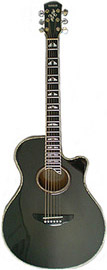
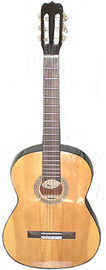 |
Differences between steel-string and classical acoustics.
- Strings. The classic guitar's nylon strings produce a round, mellow sound
- String tension. The classic guitar has a string tension of 75-90 pounds whereas the steel-string has a string tension of 150-200 pounds. Thus, the strings of a classic guitar are much easier to fret than a steel-string acoustic.
- Never fit a classical guitar with steel strings. Disastrous consequences.
- Fingerboard. The fingerboard of a classic is 50 mm at the nut whereas the steel-string is 40 mm. The wide fingerboard of the classic is designed for intricate finger picking. In contrast, the narrow fingerboard of a steel-string acoustic, 40 mm at the nut, is optimized for playing with a pick.
- String length. The longer string length from saddle to nut of the classic (650 mm vs. 644 mm for steel-string acoustics) enhances the bass response and sustain.
- Upper fingerboard access. The neck joins the body at the 12th fret on classics and at the 14th fret on most steel-strings. Short necks yield a sweeter timbre but are more difficult to play above the 12th fret.
- The classic body style is smaller and thus easier to hold than most acoustic designs.
- The reason the neck is wider on a classical guitar is so that the guitarist can more easily pluck the strings. Traditionally, classical guitars are plucked rather than strummed, however that doesn't mean you can't pick up a classical guitar, and a pick, and start strumming away. We're talking tradition, not laws of the land.
- Nylon strings tend to go out of tune more easily than steel strings. Nylon strings usually need to be tuned a little, each time you play, while steel strings will often hold their tuning for quite a while.
- If you're learning to finger pick, a nylon string guitar is far easier on the nails of the right hand. The nylon strings have far more play and feel softer to the touch.
- A nylon string guitar is far easier to fret in an effort to gain a clear tone. callused fingers are not as necessary to minimize the pain of fretting as they're on steel string guitars. Steel strings have far more tension making them more difficult to fret on average...however, some steel string guitars can be set up to have a tremendously low action making it easier to fret; even with this low of an action, a nylon string guitar would beat it for ease of playability.
- Steel-string guitars are great for rocking out on, and nylon string guitars are great for finger picking and softer styles of music, including country. Willie Nelson usually plays his classical (with pickup) guitar live in concert.
|
Check out the different neck widths between the two types (below)
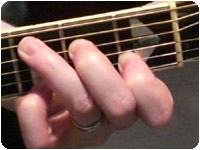 |
Steel-string acoustic
Neck: 40mm width
Nylon-string acoustic.
Neck: 50mm width
| 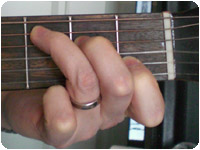 |
Make sure you try both types out before you make your decision on an acoustic.
Electric guitar: If you've decided that rock, hard rock, thrash, metal etc are the sub-genres of popular music that you're intent upon persuing, then an electric guitar would seem to be the best weapon of choice. However, regardless of what style you'd like to play, beginning is beginning and for your initiation into the world of chords, strumming etc, an acoustic may still be the best idea, and bear in mind that Nirvana did do a concert on acoustic instruments and that most accomplished electric guitarists would definitely have an acoustic axe lying somewhere around the apartment, or villa or whatever those dudes live in these days.
One of the advantages of electric guitars is that they can use lighter gauge strings, which are easier on the fingers. Light-gauge strings don't work on acoustic guitars so well as they don't generate a lot of sound, but this problem is alleviated on an electric via its ability to TURN THE VOLUME ON THE AMPLIFIER WAY UP!

3. What size pick should I use?
Picks come in all sizes, colours, levels of hardness and composition. It's a personal choice to an extent, although generally, picks for strumming tend to be larger than those used by lead guitarists. The main criterion is comfort. Go to your guitar shop and badger the concerned staff member into allowing you to try every type of pick they have. Eventually you'll hold one which seems to make playing a little easier than others. Or you may find a few that do.
For my part, I can say that I prefer a Jim Dunlop .73mm pick, which has a semi-hard rubbery feel in contrast to a hard plastic one. It also has words and a hard groove imprinted on both sides, which I find helpful in holding onto it.
4. What strings should I use?
Eventually the strings which came fitted on your first guitar will break, or the sound will lose its brightness, especially if you don't wipe them down after playing. Then it's decision time: "What sort of strings are best for me?"
Heavy gauge strings
- Produce more volume
- Sustain longer
- Stay in tune longer
- Harder to fret (press down)
|
Light gauge strings
- Not as loud
- Great for beginners
- Easier on the fingers, but
- Go out of tune faster
|
| There are 2 main types of heavy and light gauge strings. Each has its own innate "sound and feel" and you'll discover which you prefer simply by trying a set of each.
|
Acoustic 80/20 Bronze Guitar Strings
- Extra Light .010 .014 .023w .030w .039w .047w
- Light .012 .016 .025w .032w .042w .054w
- Medium .013 .017 .026w .035w .045w .056w
|
Acoustic Phosphor Bronze Guitar Strings
- Extra Light .010 .014 .023w .030w .039w .047w
- Light .012 .016 .025w .032w .042w .054w
- Medium .013 .017 .026w .035w .045w .056w
|

5. How often should I practice?
Consistency is the key. Practising for a short time every day yields better results than leaving the guitar alone for five days, then doing a four-hour practice session to catch up. Remember, you'll develop finger calluses faster by pressing those strings for a while each day. If people start complaining about the "same noises over and over and over again" you can practise chord changes, even while watching TV, by not strumming, but simply moving your fingers through a series of open chords, such as C - Am - D - G - Dm - A7...etc, silently improving your ability to change chords faster, meanwhile hardening those fingertips.
If you can do 30 minutes per day, you're doing okay.
6. How should I care for my guitar?
- Clean the strings after each use. Your guitar shop has great (lint-free) guitar string and body cleaning cloths.
You can use a regular cloth, but I find the commercial cloths, with a touch of alcohol (on the cloth) very useful. Wrap the cloth around the string at the bridge and run it up the string as close to the nut as possible.
- Don't leave your guitar in direct sunlight, in the car, inside the glass door leading to the pool, beside the motorbike while you're checking the spark plugs. It's a precision instrument and will react badly to extreme heat and cold. It is most comfortable and will yield best results if kept in cool dry conditions, preferably in its case while not being played.
- A bit of lemon oil on the fretboard once a year or so will be appreciated, by the fretboard.
- There's nothing wrong in being a little "precious" about your guitar, not allowing non-players to handle it. Many guitarists will not allow anyone to handle their guitar, regardless of how well they reckon they can play "Smoke On The Water".
- If you're storing the guitar for a while, loosen the strings a little.
- Have a guitar technician check your instrument out periodically, to make sure the neck and frets are in good condition.

7. What is a metronome?
A metronome is a device used to mark time by means of regularly recurring ticks or flashes at adjustable intervals. This device is very important for developing the guitar student's rhythm. They've been around for centuries and come in basic types:

Electronic metronome |
Most modern metronomes are electronic, with a quartz crystal to maintain accuracy, comparable to those used in wristwatches. The simplest electronic metronomes have a dial or buttons to control the tempo; some can also produce a tuning note (usually A440 hertz). They range from simple credit-card sized devices to the complicated "Dr. Beat", manufactured by Boss, which can play polyrhythms and can "count aloud", using a sampled voice.
At right is the wind-up metronome, which uses an adjustable weight on the end of a rod to control the tempo: slide the weight up the rod to decrease tempo, or down the rod to increase tempo. The pendulum rod swings back and forth in tempo; mechanics inside the metronome produce a clicking sound on each swing of the rod.
|
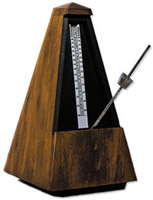
Traditional-style metronome |

8. What is a capo?

A "Shubb" capo |
A capo is a useful device which virtually shortens the neck length, raising the pitch of the strings. Using a capo is one means of bypassing using "barre chords", which require "barring" the fret with one finger and are tough to master initially, for some.
There are several different styles of capo available, utilizing a range of mechanisms, but most use a rubber-covered bar to hold down the strings, fastened with a strip of elastic or nylon, a cam-operated metal clamp, or another device.
The best thing about capo's is hearing the open chords you know, sounding fresh, bright and new as they produce new chords based on the capo's position.
|
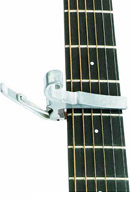
Capo fitted to a guitar neck |
9. Should I buy a case for my guitar?
Yes, yes and yes. Not only does a case protect your guitar, but it gives you a handy container in which to store other useful guitar-oriented stuff, such as:
- A spare set of strings
- A string turner
- A pair long-nose pliers for string pulling and cutting
- Music - songbooks or your own music
- Mobile phones, iPods, lunch (don't forget and leave it in there till Saturday)
The options are hard case or soft (gig) case, and each has its own advantages.
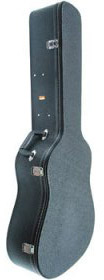 |
The Hard Case
- A hard case offers the best protection to your guitar.
- It's durable. It will take being fallen on, stood on and dropped from back of truck.
- More bulky in size
- Weighs more to carry
- Better protection for leads, strings etc
|
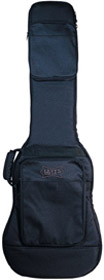
|
The Soft Case
- Takes up less space
- Lighter to carry
- You can strap one on your back and ride your bike to the gig
- No shock resistance
- No crush resistance
|

10. What does guitar string "action" mean?
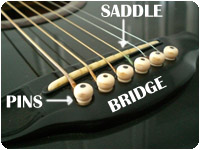
|
"Action" refers to the distance between the strings and the fretboard.
The strings can be raised and lowered on an acoustic guitar via the saddle, which is the piece of bone or plastic, over which the strings run from the bridge of the guitar. The higher the saddle is, the higher the strings will sit above the fretboard, and the higher those strings are, the harder they are to play.
|
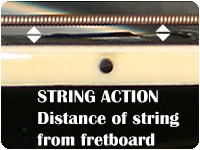 |
So, the idea is to have the saddle adjusted so as to have your strings sitting as low as possible, without causing fret "buzz" or fret "rattle" as some call it. Adjusting the saddle usually means shaving it until it sits at the right height.
|
11. What does "playing in the key of G" mean ?
For every note in the musical alphabet, there are chords which correspond with them. Chords can be grouped in a series of "families", which means that there are certain chords which go well when following or preceding other chords.
Basically, if you're in the "key of G", the "G" is regarded as "Number One" when counting the eight notes of the major scale
(think "Doh! Re Mi Far So..." etc and you'll get the idea of the "Major scale")
Now, lets just consider the musical alphabet for a minute.
It runs: A B C D E F G (and again A B C D E etc)
Let's also consider that A=1, B=2, C=3 etc.
The closest members within a chord family are the First, the Fourth and the Fifth, all major, as well as the Sixth minor.
So, if we were to say that A=1, then D=4 and E=5. If you were playing in the key of "A", there's a good chance you'll be playing A major, D major and E major chords.
Likewise, in the key of "G", G=1, C=4 and D=5
This a very basic explanation, which has not included sharps and flats. Knowledge of which chords go well together and why, is fundamental to the progress of the musician inside you and you will need to have "down cold" the formulas behind this theory. It's not difficult, but it does require you to think outside the circle a bit. Once the picture starts to come into focus, there's a good chance your understanding of music will expand exponentially...(a lot). Check out the answer to Question 17 for related info.

12. Should I learn to finger pick?
Finger picking brings a whole other thing to guitar playing and I'd recommend you try it out. Her's some info...
"Finger picking" (also called "thumb picking", "alternating bass" or "pattern picking") is a term that is used to describe both a playing style and a genre of music. It falls under the "finger style" heading because it is plucked by the fingers, but it is generally used to play a specific type of folk, country-jazz and/or blues music. In this technique, the thumb maintains a steady rhythm, usually playing "alternating bass" patterns on the lower three strings, while the index, or index and middle fingers pick out melody and fill-in notes on the high strings.
The style originated in the late 1800's and early 1900's, as Southern African American blues guitarists tried to imitate the popular ragtime piano music of the day, with the guitarist's thumb functioning as the pianist's left hand, and the other fingers functioning as the right hand."... Wikipedia
Travis Picking, named after Merle Travis, involves playing a steady bass pattern with the thumb and filling out some syncopated rhythms with the fingers of the right hand (assuming a right handed guitarist). It is a great accompanying style for folk and ragtime music amongst other styles.
13. Should I learn to read music?
It depends on why you decided to pick up the guitar. If you simply want to learn a few chords, say enough to strum some Jack Johnson, Dylan etc, you don't really need to know how to read notes, or even chords. After all, the Beatles couldn't read chords, let alone notation, and they did pretty well...
However, if you're looking to really get into the world of music via the guitar, learning how to read music is essential. Look at it this way. If you were planning to spend a few weeks in France, you'd probably pick up a phrase book, but if you decided to live there, you'd learn to read French, as well as speak it, n'est-ce pas?
14. What is tablature (TAB)?
Tablature is a style of notation peculiar to stringed instruments. Tablature, (or "TAB" for short) for guitar consists of six lines, which represent the six strings, on which are written the fret numbers you're supposed to pick or strum.
In a way TAB is a halfway point between complete lack of comprehension of reading music, and reading notation, which consists of the actual notes written onto the treble staff, complete with note lengths, song keys etc. It's an excellent method of transmitting musical ideas quickly and has been firmly supported by guitarists the world over. There are a number of useful TAB computer programs, such as Guitar Pro, which are a useful tool for the guitarist.

15. What is a chord chart?
A chord chart is exactly what it says it is: a chart of chords. Most songs, especially popular songs, regardless of the genre, are based on musical formulas which allow a guitarist to write down the chords which underly the song's melody. Armed with the chord chart, you can usually play through a song almost immediately.
Here is the chord chart for "Mad World", which is in 4/4 time, so you count 4 beats for each chord.
Lyrics are just for reference.
 All around me are familiar.... All around me are familiar.... |
| Em | G | D | A | Em | G | D | A | |
| | Em | G | D | A | Em | G | D | A | |
 And I find it kinda funny.... And I find it kinda funny.... |
| | Em | A | Em | A | Em | A | Em | A | |
 Mad world.... Mad world.... |
| | Em | A | Em | A | Em | A | Em | A | |

16. What is a chord progression?
The chord chart above is charting the progression of chords which underly the melody of "Mad World", so you could refer to the first line, consisting of "Em - G - D - A" as being the chord progression for the verse, and "E - A - E - A" being the chord progression for both the pre-chorus ("And I find it kinda funny...") and the chorus itself ("Mad world....")
17. What is the "Nashville system"?
The Nashville system is a method of writing down a chord progression, turning the chords into numbers (usually Roman Numerals so that the numbers don't get confused with chord extensions, such as 7ths and flatted 5ths etc), which allows the player to play the song in another key easily, based on the numbers of the chords relative to each other.
Using the Nashville system requires that the player have a good understanding of which chords fit within the "key" of a song, multiplied by all possible keys, which happens to be 12.
Here's an example
| | C | Dm | Em | F | G | Am | Bm7-5 | C | |
| | I | IIm | IIIm | IV | V | VIm | VIIm7-5 | I | |
18. Why do my strings buzz when I make a chord?
There could be a number of reasons. All things being equal it's probably because you're not pressing your fingers down hard enough onto the string, which causes it to buzz or rattle against the fret you're pushing it towards. Initially, it may seem real uphill battle to get those chords to play "cleanly", but with practise, things will improve.
Having said that, let's cover all the bases. Why might those string be buzzing..?
- You may not be pressing your strings hard enough against the fret board.
- Your fingers may not be on their tips.
- Your fingers may be touching an adjacent string, just enough to cause it to buzz.
- Your finger may not be placed directly behind the fret. "You gotta put it behind the bar."
- You may need to have your guitar inspected by a guitar technician.

19. Does loud music cause hearing problems?
You bet it does.
You only get one set of eardrums (unless bionic science really leaps forward during the next 20 years or so) and, whether you subject your ears to loud music or not, they are going to deteriorate over time anyway, so you must do all you can to preserve the integrity of your hearing.
Many musicians nowadays wear earplugs when performing live. This might seem a little weird, as you'd expect everybody to want to rock right out and bang the head along to the block-rockin'-beats, but when you think about it, the audience will do that every now and then, but the musicians would be subjecting their precious hearing to damage during every performance.
That would be dumb.
Given that loud guitar music is about 40 years old, there are a number of baby-boomer generation musicians who now complain of increasing loss of hearing, including Pete Townsend, who puts his rising deafness down to, not loud live music, but cranked-up headphones streaming that supersonic sound through the head for hours. ("Hope I die before I get old....and deaf.")
More about hearing loss here
20. Should I take private guitar lessons?
Say you want to drive a car and you've never done it before. You could, with enough time and empty streets, work out what the pedals mean, how to use the clutch and shift gears, turn corners and stay on the right side of the road.....eventually. An experienced teacher, on the other hand, already knows how to present you with the information you'll need, a bit at a time, so that you progress at your own speed and not knock any pedestrians down in the process.
Many guitarists have become amazing virtuosos without one guitar lesson. Whether or not you feel the need to have a professional guide help move you in the right direction will depend on you. You'll definitely learn faster with a teacher who can see your progress and plans the next move accordingly and you'd be surprised how many leading professional musicians take lessons from teachers known to have an insight into a particular method or style.
In short, take a lesson or two, with different teachers and see whether the advantage of his or her experience and method feels right for your education. If you find a teacher you can relate to, it can be a musically rewarding experience for both parties.
21. Are videos a good way to learn guitar?
Yes, videos are a good way to learn to play the guitar because you can watch them over and over again. However, not all videos are good and a great player isn't necessarily a great teacher. If possible, talk to a friend who has seen the video and ask him his opinion. You may ask a salesman at the local music store to guide you in purchasing a video that fits your needs.

22. What guitar books and magazines do you recommend?
There are a couple of well known magazines available for guitarists, dealing with all aspects of guitar knowledge.
is one, and is another. If a magazine is in the news agency, it's had to prove itself to get there, so check out all mags you find there, including sub-genres like bluegrass, heavy metal, jazz mags etc. There are gems of info included in all of them. Here are a couple I have and recommend. You can purchase them directly from Amazon.com by clicking on the pics or the titles.
BOOKS
|
 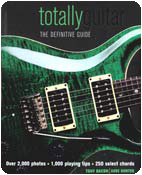
|
TOTALLY GUITAR - THE DEFINITIVE GUIDE
This huge, well-illustrated, hardbound book is an unrivalled guide to the guitar.
It presents the stories behind 100 key electric guitar makers, from Alembic to Zemaitis, with photos of the greatest models from the 1930's to the 2000's. Here too is advice on how to string, tune, set up, clean, maintain, and store a prized instrument, plus essential tips on 10 hot playing styles from acoustic to rock'n'roll. A modern bible for the guitar-obsessed. 1250 bars of music, 250 chords, 2000 photos and illustrations (color and b&w), and more than 1000 expert tips and tricks. An excellent price for this enormously encyclopedic book. |
 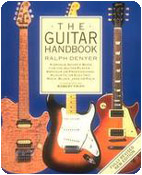
|
THE GUITAR HANDBOOK
The Essential Encyclopedia for Every Guitar Player!
The Guitar Handbook is the complete guide to playing the guitar - from simple chords to advanced improvisations. Its uniquely devised learning program combines specially commissioned, step-by-step photographs with a chord dictionary containing over 800 easy-to-follow fingerings, and clear, concise text. It is also a comprehensive manual on guitar hardware and performance technology, sound equipment, special effects, and recording facilities. |
  |
GUITAR FOR DUMMIES
The 500,000-copy bestseller, now revised with 25 percent new material and an all-new interactive CD.
Now revised and updated, this is the perfect introductory guide for all those novice acoustic and electric guitar players. It offers easy, step-by-step instruction on fingering chords, strumming and picking, using specialized techniques like the slide, and playing in a wide range of guitar styles, from rock and blues to folk and classical, plus tips on selecting the right guitar, maintaining it, and finding the best accessories. |

23. What are power chords?
Power chords are created via a combination of the two strongest notes of a chord, namely the first and fifth, played usually on an electric guitar through an amp at volume, and it is this combination of elements which provides that "power chord" sound.
More precisely, the two essential notes are normally played on the 5th and 6th strings, with the fifth note being on the fifth string, two frets higher than the tonic or root not. Thus "A" on the 6th string (5th fret) played together with "E" on the 5th string (7th fret) is a great place to start when playing power chords.
Power chords can also be achieved by drop tuning the 6th string down to D and playing the lowest three strings as a chord, or tuning the whole six strings to the tonic and 5th of a major chord, such a E, D, G, A or C and playing all strings, at volume.
24. What are open chords?
Open chords are those chords which incorporate open strings and fretted strings, normally the first chords you learn on the guitar and consist of E major, E minor, E7, Em7, D major, D minor, D7, Dm7, A major, A minor, A7, Am7, G major, C major and B7. There are more, but this should give you an idea.
Open chords are the ones you see denoted by TAB boxes:

25. What is an electronic tuner?
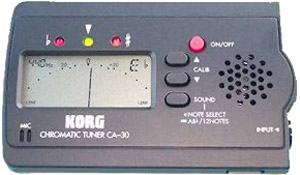
|
An electronic tuner is a device, usually run on batteries, which has either a tiny microphone, or a phono lead jack input, sometimes both. In the case of an acoustic or electric guitar, once it's plugged in, or is in the vicinity of the tuner, you pluck the strings, one at a time, and the tuner converts the audio signal into a sound wave which it can then interpret the frequency of. It then measures the inputted frequency against the given frequency expected for each of the strings, and illustrates the difference via a needle graph, or LED lights, showing the pitch of the string to be either above or below its "in tune" frequency.
|
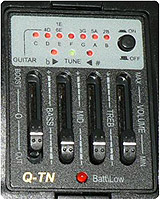
|
Many acoustic guitars now days, especially those which feature an internal electronic pickup and associated volume and equaliser controls built in, include an electronic tuner. This allows the player to check, at any time during a performance, whether the strings are currently in tune. For electric guitarists, many multi-effects processors also have tuners built in
The downside of this innovation is that guitarists are not required as much now to develop the ability to tune their guitar via ear, a useful ability and one which impacts on other areas of a guitarists education.
|
26. What is a tuning (pitch) fork?

|
A tuning fork is a simple metal two-pronged fork with the tines formed from a U-shaped bar of elastic material (usually steel). A tuning fork resonates at a specific constant pitch when set vibrating by striking it against a surface or with an object, and after waiting a moment to allow some high overtones to die out. The pitch that a particular tuning fork generates depends on the length of the two prongs, with two nodes near the bend of the U.
|
Tuning forks can be tuned by removing material off the tines (filing the ends of the tines to raise it or filing inside the base of the tines to lower it) or by sliding weights attached to the prongs. Most tuning forks are tuned to concert pitch (A=440 Hz). When struck, then placed against an amplifying agent, such as a soundboard, the pitch can be used to tune a guitar.
|

27. What is a pitch pipe?
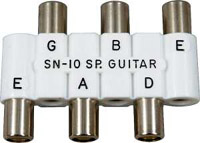
|
A pitch pipe is a small device used to provide a pitch reference for musicians without absolute pitch. Although it may be described as a musical instrument, it is not typically used to play music as such.
At left is a pitch pipe, specifically designed for the 6-string guitar. Each of the "pipes" within the device corresponds to E - A - D - G - B - E strings on the guitar. To tune the guitar, you simply blow on the note and tune the corresponding string.
|
28. When changing strings, is there anything I should know?
You bet there is. If it's all possible, watch someone with experience in changing a set of strings. Having gone through it many, many times, they will have developed a method whereby the old strings are taken off and new strings fitted, without damage to the strings, guitar or guitarist, which can sometimes be the case.
There are a number of essential items when changing strings on a guitar. The most important are;
- A guitar, and
- A set of new guitar strings.
Presumably you have these.
Here's a couple of other useful items, which will aid you to complete the task quickly and efficiently.
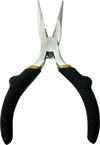
|
Long-nose pliers.
These are really useful for a couple of reasons.
- If your strings are held in by pins, they can extricate the pins (pull 'em out) comfortably, without damage.
- Once you have a string wound a few turns and tightened, it can "cut and curl" the string. This means cutting the string relatively close to the tuning peg hole, then curling the end so that the cut and possibly dangerous piece of steel string cannot puncture your thumb or finger. If you've ever been cut by an uncurled string, you'll know the value of this procedure.
|
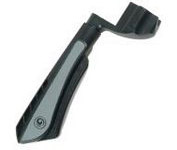
|
String winder.
To have adequate tension on your strings, they need to be wound around the tuning peg at least three revolutions. Lighter strings actually need double that, or more.
This means those tuning pegs need to be turned and turned and turned, which can be quite a time-consuming exercise, unless you have a handy string winder, which reduces the effort and irritation.
|

29. What is palm muting?
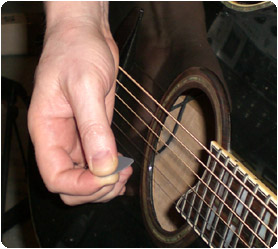
|
Palm muting is a method of playing the guitar strings, either strumming or individually plucking them, while resting part of the palm of your hand across the strings, near where they meet the bridge. As a technique, it takes a little while to achieve, as the strumming or plucking hand is more restricted than usual.
This has the effect of "muting" the sound, taking the treble edge, or harshness, out of the sound.
This playing techniques is particularly popular with rock and hard-rock guitarists, but is used equally effectively on an acoustic guitar, playing any type of music. Combining palm muting and non palm muting strumming is also an interesting strumming technique, yielding quite powerful results, once mastered.
|
30. How can I improve my rhythm?
There are a couple of ideas which may be useful
- One of the essential ingredients in music is the understanding and use of tempo.
Once you've been introduced to your first few chords and shown a basic strumming pattern, you'll feel the need to make those chord changes as fast as possible, as this is what guitarists seem to be doing when playing a song.
However, what is far more important than simply making the chord changes, is making them within the structure of the tempo of the song.
Strumming a chord for a bar quickly, then coming to an abrupt halt while you figure out the fingering for the next chord, is actually counterproductive to your improvement as a guitarist.
You'll find you'll achieve a better understanding of rhythm, as well as develop a rhythmic ability faster, by choosing a tempo which is as slow as your slowest chord change, and then sticking to that rhythm for the whole piece.
This may sound simple, but in actual fact to achieve it you'll have to fight against your natural inclination to race through the strumming of the chord towards the goal of arriving at the next one.
Try this method out. If the chord changes are coming slowly, set a sloooow tempo. Really slow, like you could take a breath in and out before you reach beat 2 of the bar, then STICK TO THAT TEMPO! If you do this, you'll find you have the time top make the changes, while remaining within the rhythmic structure of the song, which means you are playing music, not making a series of noises on a guitar.
- Remember the metronome, back a few questions? These are great devices for improving rhythm as you can set one to a tempo and it will beep away at exactly that tempo, demanding you stay up with, or slow down to it as the case may be.
- Drum machines, likewise, are useful devices for helping you maintain rhythm.
- Let's not forget drummers. As a matter of fact, playing with other musicians is a great way of improving your rhythm, as you'll have the experience of interacting with the rhythmic pulses created.

31. What is vibrato?
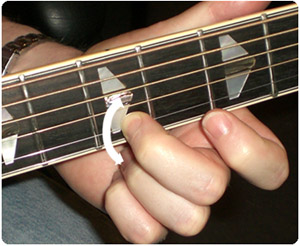
|
Vibrato is a technique, employed by the fretting finger, of moving the fretted noted back and forth, quite quickly, so as to cause the note's pitch to rise and fall slightly. There are a couple of methods of achieving vibrato on a guitar.
- Wrist: While pressing down on a fret, rotate your wrist back and forth using the point where the forefinger makes contact with the side of the neck as a pivot point. The thumb should be used to counteract the force generated by this movement.
- Finger: Keeping the wrist and hand relatively stable, simply move the fretting finger back and forth to achieve the vibrato. To achieve a greater scale of vibrato, you may use the added strength of another finger behind the fretting one.
|
32. How can I change chords faster?
- PRACTISE!
- Use the time you have to your best advantage.
You'd be surprised how many guitar students, when practising a series of chords, strum the required bar length of the first, then arrive at the second without having thought ahead as to what the next chord is and how to change the fingers from the last chord to the next.
One thing I impress upon my students is that, when they embark upon "playing" a piece of music, they cease to have the luxury of simply listening to the music itself. They have become servants to the ears of those who are listening, even if those ears won't hear the piece for quite a while into the future. You are at work, which means you must be on your toes, thinking of what task you are currently performing, as well as preparing for the next immediate task, which in this case is changing fingering to the next chord shape, as well as looking down the track to what is coming, such as repeat bars etc.
Once you've strummed the last beat of the current chord, you should immediately begin making the shape of the next one, regardless of the effect this has on the sound. By demanding of your fingers that they make the change in the allotted time before the next beat falls, and of course, playing the changes at a tempo your fingering can handle, your muscle memory will begin to kick in and the fingers, painfully slowly it will seem to you, will eventually get to the station before the train is due to depart from the platform of the next chord.
- PRACTISE SOME MORE!

33. What are steel string and nylon string guitars?
- Nylon string guitars are guitars, usually classical, with the figure 8 shape, which use the modern equivalent of cat gut strings, which provide a mellow and soft sound.
- Steel string guitars are more varied in shape, but are strung with strings made of steel, or a metal alloy, which provides a sharper, richer tone.
See the answer to Question 2 for more information about these differences
34. Should I practice with a drum machine?
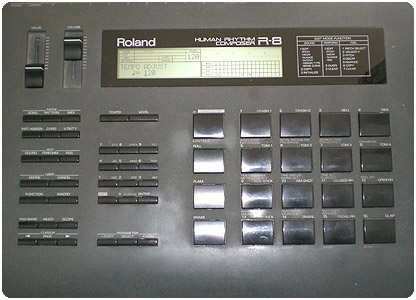
|
Drum machines are very useful tools for guitarists and instrumentalists of all types. They are programmable (the programmable ones are, at any rate) and will keep a constant rhythm for weeks on end, which may be disconcerting to neighbours if you leave your amp and drum machine on, and something happens to trigger the "start" switch, just after you've left for a 2-week holiday.
At left is one example of a perennial favourite among drum machine enthusiasts, The Roland R-8 Human Rhythm Composer - Drum Machine.
By all means use a drum machine to practise with.

|
|
